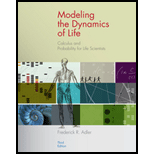
a
To calculate: To find the number of butterflies after migration and after reproduction using the given values
a
Answer to Problem 37E
There are
Explanation of Solution
Given information: Each year, 20% of the butterflies from the first island fly to the second and 30% of the butterflies from the second fly to the first.
Calculation:
Suppose that two nearby islands have populations of butterflies, with
Consider the first island. In the beginning there are 100 butterflies out of which 20 migrate to the second island and 30 migrate from the second island to the first island.
Hence, there are
Now consider the second island- In the beginning there are 100 butterflies out of which 30 migrate to the first island and 20 migrate from the first island to the second island.
Hence, there are
Again consider the first island. Now there are 190 butterflies out of which 38 migrate to the second island and 33 migrate from the second island to the first island.
Hence, there are
Now consider the second island- In the beginning there are 110 butterflies out of which 33 migrate to the first island and 38 migrate from the first island to the second island.
Hence, there are
b
To calculate: To find the equations of
b
Answer to Problem 37E
The equation for
Explanation of Solution
Given information: Each year, 20% of the butterflies from the first island fly to the second and 30% of the butterflies from the second fly to the first.
Calculation:
Now the equation for
Also, the equation for
c
To calculate: To find the discrete-time dynamical system for
c
Answer to Problem 37E
Explanation of Solution
Given information: Each year, 20% of the butterflies from the first island fly to the second and 30% of the butterflies from the second fly to the first.
Calculation:
To find the discrete-time dynamical system for
d
To calculate: To find the equilibrium of
d
Answer to Problem 37E
Explanation of Solution
Given information: Each year, 20% of the butterflies from the first island fly to the second and 30% of the butterflies from the second fly to the first.
Calculation:
To find the equilibrium
Now using the
This is larger because the butterflies from the first island reproduce.
e
To calculate: To draw the graph using the obtained values
e
Answer to Problem 37E
Hence the graph is drawn using the obtained values.
Explanation of Solution
Given information: Each year, 20% of the butterflies from the first island fly to the second and 30% of the butterflies from the second fly to the first.
Calculation:
The graph and the cobweb are as follows:

Want to see more full solutions like this?
Chapter 1 Solutions
Modeling the Dynamics of Life: Calculus and Probability for Life Scientists
- Algebra & Trigonometry with Analytic GeometryAlgebraISBN:9781133382119Author:SwokowskiPublisher:Cengage
